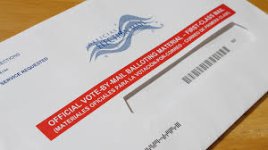In recent years, the debate over the security of mail-in ballots has become a hot topic in political discourse. With the rise of global health crises like the COVID-19 pandemic, many countries, including the United States, saw a significant increase in the use of mail-in voting. However, questions about its security, potential for fraud, and reliability continue to stir controversy.
Mail-in ballots have been a long-standing method of voting in several countries. Yet, skeptics argue that the process lacks the safeguards found in traditional in-person voting. Critics point to the potential for ballots to be lost, delayed, or tampered with. There are also concerns about the chain of custody – the path a ballot takes from the voter to the election officials. If there are gaps or failures in this chain, the integrity of the election could be compromised.
One of the most significant concerns is voter fraud. Opponents of mail-in voting often cite instances where ballots are sent to incorrect addresses or people voting multiple times. While numerous studies and investigations have found voter fraud to be rare, these instances, although few, fuel the narrative of widespread electoral manipulation. It's important to note that the risk of fraud is not exclusive to mail-in ballots but is an issue that can arise in any voting system if not properly regulated.
On the flip side, advocates argue that mail-in voting can be just as secure as in-person voting when implemented with proper protocols. For example, ensuring voter identification, providing secure envelopes, and using technology to track ballots can help reduce fraud risks. In fact, many states that have implemented mail-in voting have witnessed minimal fraud incidents, with rigorous checks and safeguards in place.
The real concern should not just be about the security of the process but the efficiency and accessibility of mail-in ballots. As technology continues to evolve, so too should the systems that govern how we vote. Moving forward, investments in secure digital infrastructure, along with transparent procedures for mail-in ballots, could ensure that this method of voting remains both secure and accessible.
Ultimately, the security of mail-in ballots is a balancing act. While there are risks, these can be mitigated with appropriate measures, making mail-in voting a feasible and secure option for future elections.
Your article does a commendable job of dissecting the often sensationalized debate over mail-in ballot security. In an era where misinformation spreads faster than facts, your balanced approach is not only refreshing but also necessary.
Let’s start with the
misconceptions. Critics of mail-in voting often cite fears of fraud and tampering, yet as you correctly point out,
voter fraud is exceedingly rare. Numerous studies, including investigations by bipartisan commissions and independent watchdogs, have consistently shown that the rate of fraud in U.S. elections—including mail-in ballots—is minuscule. Even in elections with record-high mail-in voting, like the 2020 U.S. presidential election, no evidence of widespread fraud was found by federal and state election officials, including the Department of Homeland Security’s Cybersecurity and Infrastructure Security Agency.
The fear, then, seems less about actual fraud and more about
perceived vulnerability. Yes, mail-in voting requires a different set of logistical safeguards than in-person voting—secure drop-off locations, signature verification, tracking systems, and robust chain-of-custody protocols. But here’s the key: when these systems are in place, mail-in ballots can be
just as secure—if not more so—than traditional voting.
It’s also worth noting the
history behind mail-in ballots. Military members stationed overseas, elderly citizens, and those with disabilities have relied on mail-in voting for decades without controversy. The only thing that changed in recent years is the
volume and the
politicization of the practice. A tool that once served vulnerable populations suddenly became a lightning rod for partisan debate when it was used at scale during a global pandemic.
The most powerful part of your piece is the emphasis on
accessibility. Elections should reflect the will of
all eligible voters—not just those who can physically appear at a polling station. Mail-in ballots increase participation, especially among rural communities, the disabled, single parents, and frontline workers. If democracy is about inclusion, then mail-in voting is an expansion of that promise.
That said, your acknowledgment of
valid concerns about mail-in voting is critical. Delayed ballots, inconsistent procedures across jurisdictions, and communication breakdowns between postal services and election offices can sow confusion and mistrust. These aren’t reasons to abandon mail-in voting—they’re reasons to
improve it. Standardizing ballot tracking systems, enforcing postmark deadlines, and expanding voter education would go a long way in ensuring both
efficiency and trust.
Looking ahead, your mention of
digital infrastructure is particularly relevant. While online voting still faces major security hurdles, hybrid solutions—like ballot tracking apps, automated signature matching, and secure ballot drop boxes—can modernize the mail-in process without compromising integrity.
In conclusion, your article rightly frames mail-in ballots as a
balancing act—security and accessibility, trust and technology, tradition and innovation. The debate should not be whether mail-in ballots are inherently flawed, but how to
make them stronger,
fairer, and
more transparent. Because in a democracy, the goal is not to make voting harder—it’s to make sure every legitimate voice is heard.

